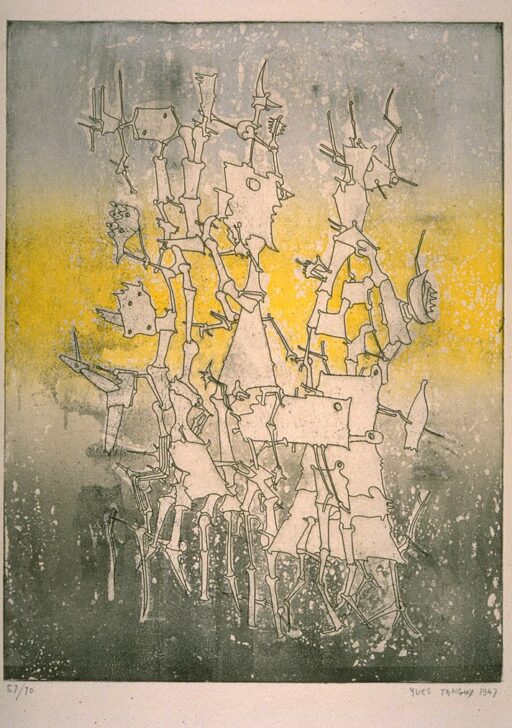Rhabdomancie
Yves Tanguy; Brunidor Editions; Atelier 17

Description
At the request of art critic Nicholas Calas, seven Surrealist artists collaborated on a print portfolio published by Brunidor Editions, in New York, whose director was Robert Altmann. The artists were Max Ernst, Stanley William Hayter, Wifredo Lam, Matta, Joan Miró, Kurt Seligmann, and Yves Tanguy. The etchings were printed in Hayter’s Atelier 17, while the lithographs were pulled in the studio of Alfred Jones.
Calas’ introduction to the portfolio turned on the age-old controversy between line and color, in which line or form is seen as relating to thought, while color or light is considered pertinent to emotion. Excerpts from his essay, entitled "Saper Vedere" (To Know How to See), are given in italics in the labels accompanying each of the prints from the portfolio, all of which are exhibited here. Calas describes not only what these artists "see" with their imaginations, but also what he as a critic "sees" as he interprets the inherent meanings of these prints.
University of Michigan Museum of Art director Jean Paul Slusser in 1947 showed himself to be in the vanguard of contemporary trends in his recommendation that this portfolio be acquired in the very year it was published.
. . . Tanguy is led to treat color as an attribute of light and to stress its rhythmical qualities revealed at dawn or in the afterglow of a vanishing day. . . . Donquixotically battling against the void while treading on uncertain ground with his magic rod, the seer rises above himself in a quasi-totem pole fashion to combine beatific visions with sorcery.
As for example in this print for The Brunidor Portfolio, the landscapes of Tanguy are atmospherically indeterminate scenes, articulated by vaguely bonelike, rocklike excrescences. The artist’s native Brittany, with its rock formations, is said to be a constant source. Self-taught, Tanguy decided to be a painter when he saw a painting by de Chirico in a gallery in 1923. He was embraced early on by the Surrealists. After meeting his wife-to-be Kay Sage in Paris in 1939, Tanguy came that year to America, where he lived for the rest of his life.
Label copy from exhibition "Dreamscapes: The Surrealist Impulse," August 22 - October 25, 1998
Subject Matter:
This print is part of a portfolio published by Brunidor Editions, New York, the portfolio's namesake, at the request of art critic Nicholas Calas. The portfolio includes seven prints from a number of prominent Surrealist artists, including: Max Ernst, Stanley William Hayter, Wifredo Lam, Roberto Matta, Kurt Seligmann, and Joan Miró. Calas’ introduction to the portfolio turned on the age-old controversy between line and color, in which line or form is seen as relating to thought, while color or light is considered pertinent to emotion. Calas describes not only what these artists "see" with their imaginations, but also what he as a critic "sees" as he interprets the inherent meanings of these prints.
Tanguy's contribution, plate one of seven, depicts an abstract figure or figures at the center. The title refers to the practice of dowsing, or divining with rods or sticks. Allied with the broader development of his style, this work is made up of stony and bone-like structures. Like many of his contemporaries during WWII, Tanguy fled the fighting in Europe and immigrated to the United States, where he created this work.
Physical Description:
At the center of the print is a series of abstract bone-like shapes put together to resemble a creature or creatures. The background is colored, top to bottom, in blue, yellow, and green. The print is signed and dated (l.r.) "Yves Tanguy 1947" and numbered (l.l.) "57/70" in pencil.
Usage Rights:
If you are interested in using an image for a publication, please visit https://umma.umich.edu/request-image/ for more information and to fill out the online Image Rights and Reproductions Request Form.